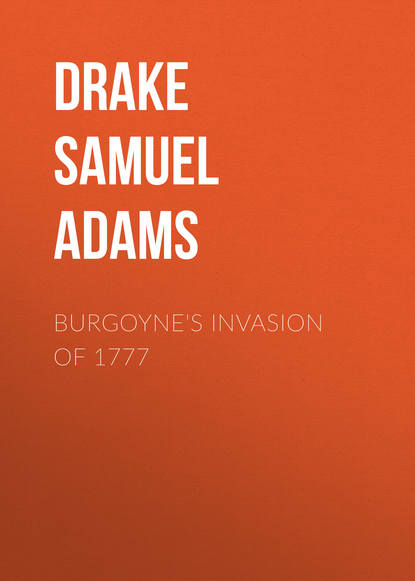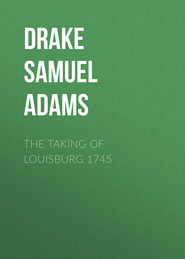По всем вопросам обращайтесь на: info@litportal.ru
(©) 2003-2024.
✖
Burgoyne's Invasion of 1777
Настройки чтения
Размер шрифта
Высота строк
Поля
10
The Removal of the Army from Crown Point to Ticonderoga was strongly opposed by Stark and others, and disapproved by Washington.
11
Guy Carleton, British governor of Canada, though driven from Montreal by Montgomery, had successfully defended Quebec against him. He reconnoitred Ticonderoga, but seems to have thought it too strong to be attacked with his force.
12
Victory at Trenton. After being driven from the Jerseys, Washington suddenly turned on his pursuers, and by the two fine combats of Trenton and Princeton, compelled much superior forces everywhere to retreat before him, thus breaking up all the enemy's plans for the ensuing campaign, saving Philadelphia, and putting new life into the American cause.
13
Underestimating his Enemy. Burgoyne candidly admits as much in his letter to Lord G. Germaine. State of the Expedition, Appendix, xcii.
14
New England the Battle-Ground. Sir William Howe did propose, at first, operating against Boston from Rhode Island, with ten thousand men, while an equal force should effect a junction with the army of Canada, by way of the Hudson. This purpose he subsequently deferred for an advance into Pennsylvania, but Burgoyne asserts that he was not informed of the change of plan when he sailed for Canada in April; and, though Sir William Howe afterward wrote him to the same effect (July 17th) a letter which was received early in August, Burgoyne, nevertheless, persisted in his intention of passing the Hudson, notwithstanding he knew, and says (August 20th), that no operation had yet been undertaken in his favor. State of the Expedition, 188, 189; Appendix, xlvii.
15
Soldiers were hired from the petty German princes for the American war. The Americans called them all Hessians, because some came from the principality of Hesse. George III. also tried to hire twenty thousand Russians of Empress Catharine, but she gave him to understand that her soldiers would be better employed. There was good material among the Germans, many of whom had served with credit under the Great Frederick; but the British showed them little favor as comrades, while the Americans looked upon them as paid assassins. Not one in twenty knew any English, so that misconception of orders was not unfrequent, though orders were usually transmitted from headquarters in French. A jealousy also grew up out of the belief that Burgoyne gave the Germans the hardest duty, and the British the most praise. At Hubbardton, and on the 19th of September, the Germans saved him from defeat, yet he ungenerously, we think, lays the disaster of October 7th chiefly at their door.
16
Indians and Irregulars. It is impossible to give the number of these accurately, as it was constantly fluctuating. Though Burgoyne started with only four hundred Indians, the number was increased by five hundred at Skenesborough, and he was later joined by some of the Mohawks from St. Leger's force. In like manner, his two hundred and fifty Canadians and Provincials had grown to more than six hundred of the latter before he left Skenesborough. Most of these recruits came from the Vermont settlements. They were put to work clearing the roads, scouting, getting forward the supplies, collecting cattle, etc. Their knowledge of the country was greatly serviceable to Burgoyne. In the returns given of Burgoyne's regular troops, only the rank and file are accounted for. Staff and line officers would swell the number considerably.
17
Feeble Plantations. No permanent settlements were begun west of the Green Mountains till after the conquest of Canada. After that, the report of soldiers who had passed over the military road from Charlestown on the Connecticut River, to Crown Point, brought a swarm of settlers into what is now Bennington County. Settlement began in Rutland County in 1771.
18
General Arthur St. Clair, of Scotch birth, had been a lieutenant with Wolfe at Quebec; he resigned and settled in Pennsylvania; served with our army in Canada; made brigadier, August, 1776; major-general, February, 1777.
19
Abercromby lost two thousand men in assaulting these lines in 1758. Since then they had been greatly strengthened.
20
Through Old Paths. The Indians had passed this way centuries before the fortress was thought of.
21
St. Clair seems to have waited just long enough for the defence to become difficult, to admit its impossibility. He chose the part of safety rather than that of glory.
22
General Philip Schuyler, one of the four major-generals first created by Congress, June, 1775. Had seen some service in the French War; was given command of the Northern Department, including Ticonderoga, Crown Point, Fort Stanwix, etc., February, 1777, as the one man who could unite the people of New York against the enemy. Gates declined to serve under him.
23
Obstructions at the Bridge. The Americans had stretched a boom of logs, strongly chained together, across the strait.
24
Seth Warner was on the way to Ticonderoga when he met St. Clair retreating. The rearguard, which Colonel Francis had previously commanded, was then increased, and put under Warner's orders.
25
Colonel Ebenezer Francis of Newton, Mass., colonel, 11th Massachusetts Regiment. His bravery was so conspicuous that the British thought he was in chief command of the Americans.
26
Fort Anne, one of the minor posts built during the French War to protect the route from Albany to Lake Champlain. It consisted of a log blockhouse surrounded by a palisade. Boat navigation of Lake Champlain began here, fourteen miles from Skenesborough, by Wood Creek flowing into it.
27
The Threatened Point. Baffled in his purpose of taking Philadelphia by Washington's success at Trenton, Sir William Howe had decided on making another attempt; but his manœuvres led Washington to believe Howe was going to Newport, R.I., with the view of overrunning Massachusetts. See Note 3, "Plan of Campaign" (p. 32).
28
Generals of the Northern Army. Schuyler and St. Clair were chiefly inculpated. Brigadiers Poor, Patterson, and De Fermoy, who were with St. Clair at Ticonderoga, were included in the order. All had agreed in the necessity for the evacuation, and all came in for a share of the public censure. Poor and Patterson nobly redeemed themselves in the later operations against Burgoyne.
29
Fort Edward, a link in the chain of forts extending between Canada and the Hudson, – first called Fort Lyman, for Colonel Phineas Lyman, who built it in 1755, – stood at the elbow of the Hudson, where the river turns west, after approaching within sixteen miles of Lake George, to which point there was a good military road. The fort itself was only a redoubt of timber and earth, surrounded by a stockade, and having a casern, or barrack, inside, capable of accommodating two hundred soldiers. It was an important military position, because this was the old portage, or carrying-place, from the Hudson to Lake George, though the fort was no great matter.
30
A Costly Mistake to give the command to an officer who could not speak English; still another, to intrust an expedition in which celerity of movement was all-important, to soldiers loaded down with their equipments, as the Germans were, instead of to light troops. Colonel Skene went with Baum. See note 4, p. 18.
31
General Benjamin Lincoln, born at Hingham, Mass., 1733. Made a major-general, February, 1777. Joined Schuyler, July 29, at Fort Miller, while our army was retreating; sent thence to Manchester. One of those captains who, while seldom successful, are yet considered brave and skilful commanders.
32
General John Stark, born at Londonderry, N.H., 1728, had seen more active service than most officers of his time. He had fought with Abercromby at Ticonderoga, against Howe at Bunker Hill, and with Washington at Trenton. Notwithstanding this, he was passed over in making promotions, perhaps because he had less education than some others, who lacked his natural capacity for a military life. Congress first censured him for insubordination, and then voted him thanks, and promotion to a brigadiership for his victory over Baum.
33
Battle of Bennington. Both actions actually occurred in the town of Hoosic, N.Y. (we cannot be held responsible for the absurd variations in spelling this name), though the troops were formed for the attack within the limits of Bennington, and Stark's despatch announcing his victory is dated at this place. A battle monument, designed to be three hundred and one feet high, is now being built on a commanding site at Bennington Centre, which is the old village. No more beautiful spot than this hill-environed valley, overlooked by Mount Anthony, could possibly commemorate to future centuries one of the decisive conflicts of the War for Independence.
34
Breyman's Retreat. The express from Baum arrived at headquarters at 5 A.M. of the fifteenth. Orders were immediately given Breyman to march. News of Baum's defeat reached Burgoyne during the night of the sixteenth. The 20th regiment, British, was immediately marched to Breyman's support. Burgoyne's anxiety was so great, that he followed it until Breyman's corps was met on the road.











